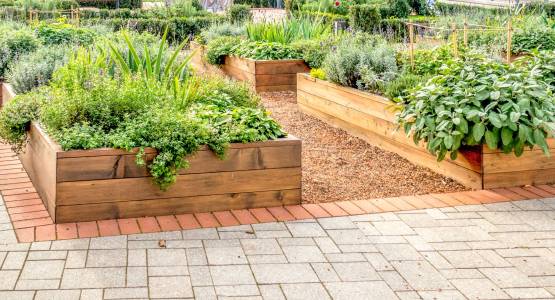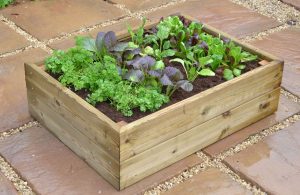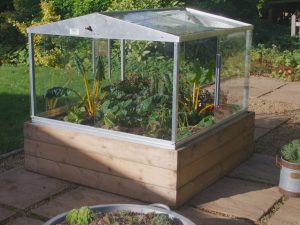What Are the Advantages of Raised Vegetable Beds in Your Garden?


Raised vegetable beds have become increasingly popular among gardeners for their numerous benefits, especially when it comes to improving plant growth and making gardening more accessible. A raised bed allows for better control over soil conditions, improved drainage, and often leads to earlier and more productive harvests. In this blog, we’ll explore the key advantages of raised vegetable beds in your garden, the benefits of adding a cold frame on top of the raised bed, and practical tips like calculating the amount of compost needed for your beds.
Improved Drainage
One of the major advantages of raised vegetable beds is improved drainage. In the UK, where rainfall can be unpredictable and heavy at times, drainage is crucial to prevent waterlogged roots, which can lead to poor plant growth or even root rot.
Benefits of Improved Drainage:
- Prevents Waterlogging: Raised beds naturally drain better than flat garden plots because the soil is elevated above the surrounding ground, allowing excess water to escape more easily.
- Healthier Roots: Well-drained soil creates the ideal environment for strong root systems, essential for growing robust vegetables.
- Reduces Compaction: In a raised bed, the soil is less likely to become compacted, which ensures better aeration and easier root penetration, leading to healthier plants. If desired, permanent gravel paths can be laid between the beds to aid access during the winter months
Enhanced Quality Soil
By using raised vegetable beds, you have full control over the soil quality, which is especially beneficial for gardeners dealing with heavy clay, sandy, or poor-quality soil. Raised beds allow you to create the perfect soil mix, enriched with organic matter, which can significantly improve vegetable growth.
Key Benefits of Better Soil:
- Customised Soil Mix: You can create a nutrient-rich blend tailored to the needs of your plants. Combining compost, topsoil, and organic matter ensures an ideal environment for growing healthy vegetables.
- Avoids Contaminated Soil: If your garden soil is contaminated or has high levels of clay or sand, raised beds allow you to introduce fresh, uncontaminated soil, reducing the risk of poor plant performance or contamination issues.
- Easier Maintenance: Since the soil in raised beds is loose and fertile, it’s much easier to work with, making tasks like weeding and planting simpler and more efficient.
Earlier Cropping
One of the most appealing advantages of raised vegetable beds for British gardeners is the ability to start growing earlier in the season. Raised beds warm up more quickly in the spring because they are exposed to the sun on all sides, unlike ground-level garden beds, which stay cooler for longer.
Advantages of Earlier Cropping:
- Extended Growing Season: By warming the soil faster, raised beds allow you to plant earlier in the spring, extending your growing season and providing you with more harvest opportunities.
- Faster Growth: Early planting combined with warmer soil conditions helps your crops grow faster, leading to earlier harvests and more frequent plantings throughout the year.
- Better for Heat-Loving Crops: Vegetables that require warm soil, such as tomatoes and peppers, thrive in raised beds, where the soil stays warmer than in traditional beds.
Reduced Bending and Strain
Gardening in traditional ground-level beds can involve a lot of bending, kneeling, and squatting, which can be uncomfortable for some gardeners, especially those with mobility issues or back pain. Raised beds offer a more ergonomic solution.
Benefits for Accessibility:
- Less Strain on Your Back and Knees: Raised beds can be built to a height that suits you, reducing the need for bending over and making gardening more comfortable.
- Accessible for All: For elderly gardeners or those with disabilities, raised beds make gardening possible without the physical strain associated with traditional garden plots. Beds can even be raised to waist height for easy access.
- Encourages Regular Gardening: The easier it is to maintain your garden, the more likely you are to tend to it regularly. This leads to better care for your plants and more consistent harvests.
Adding a Cold Frame for Extra Warmth

A cold frame is a simple structure made of transparent materials like glass that can be placed over a raised bed to trap heat and protect young plants. It acts like a mini-greenhouse, providing warmth and shelter during the colder months.
Benefits of Adding a Cold Frame:
- Warms the Soil Early: Adding a cold frame on top of a raised bed helps the soil warm up even faster in the spring, allowing you to plant earlier and extend your growing season.
- Protects Young Plants: A cold frame shields seedlings and young plants from frost, strong winds, and cold weather, giving them a better chance to establish before being exposed to harsher conditions.
- Year-Round Growing: In milder UK regions, a cold frame can be used to grow vegetables throughout the winter by protecting cool-weather crops such as spinach, lettuce, and kale.
Choosing the Right Material for Raised Beds: Wood vs Metal
Raised beds come in various materials, with wood and metal being the most common. Each material has its advantages, but for most gardeners, wooden raised beds are the preferred choice.
Wood:
- Natural Look: Wood blends well with garden aesthetics, providing a more traditional, natural look compared to metal.
- Insulation: Wooden beds offer better insulation than metal beds, which can get too hot or too cold depending on the season. This insulation helps regulate soil temperature, which is beneficial for plant growth.
- Easier to Work With: Wood is easier to customise and build into the size or shape that fits your garden, and it’s generally more affordable than metal.
Metal:
- Durability: Metal beds, particularly those made from galvanized steel, are highly durable and resistant to rot, unlike wood, which can break down over time.
- Modern Aesthetic: Metal beds offer a sleek, modern look and are less prone to warping than wooden beds. However, they may not be as visually appealing in more traditional garden settings.
Verdict: Wood Over Metal
For most gardeners, wooden raised beds offer a balance of practicality, aesthetic appeal, and insulation that makes them the superior choice. Choose a manufacturer that uses pressure treated timer for a long life and stainless steel fixings to prevent rusting. While metal raised beds are durable, the natural look and insulating properties of wood make it better suited for the variable British climate.
How to Calculate the Amount of Compost Needed
One of the key steps in setting up a raised bed is ensuring you have enough compost or soil mix to fill it. Here’s how you can calculate the amount of compost required for your raised bed:
Step-by-Step Guide:
- Measure the Dimensions: First, measure the length, width, and height of your raised bed. For example, if your bed is 1.2 metres long, 0.9 metres wide, and 0.3 metres deep, you’ll need these numbers to calculate the volume.
- Calculate the Volume: Multiply the length, width, and height together to find the volume in cubic metres. Using the example dimensions:1.2 m x 0.9 m x 0.3 m = 0.324 cubic metres.
- Convert to Litres: To convert cubic metres to litres, multiply the volume by 1,000.0.324 cubic metres = 324 litres.
So, for this example, you’ll need about 324 litres of compost or soil mix to fill your raised bed.
Tips for Filling Your Bed:
- Layering: You can save on compost by layering the bottom of the bed with organic materials like straw, cardboard, or leaves, and then filling the top layer with high-quality compost. This also improves soil fertility as the lower layers break down over time.
- Compost Quality: Use a high-quality, well-rotted compost or organic soil mix for the best results. You can also mix in manure or fertilisers to further enrich the soil.
Conclusion
Raised vegetable beds offer numerous advantages for gardeners, from improved drainage and soil quality to reduced strain and earlier cropping. The flexibility of customising soil conditions makes raised beds ideal for growing a wide range of vegetables, while the option of adding a cold frame can help extend your growing season and protect young plants. When considering materials, wooden beds offer the best balance of aesthetics, insulation, and practicality for most home gardeners.
By calculating the right amount of compost and regularly maintaining your raised beds, you’ll ensure a productive and rewarding growing season. Not only will you enjoy the practical benefits, but you’ll also have access to fresh, nutritious, home-grown vegetables that taste better and travel fewer food miles.
As we have seen in our Advantages of using raised vegetable beds in your garden guide, raised beds can be a game-changer for both novice and experienced gardeners alike, offering a versatile and effective way to grow healthy, productive crops year-round.
